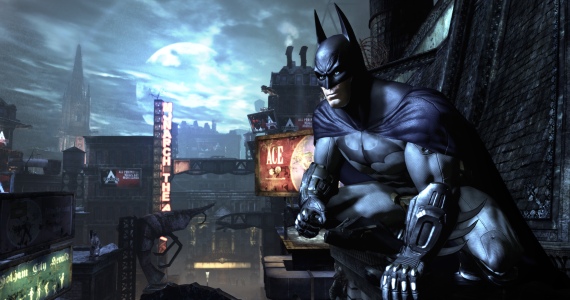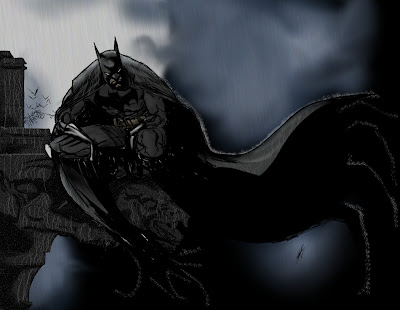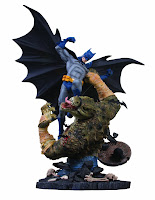Batman Character Review

Batman is a fictional Character, a comic book superhero appearing in comic books published by DC Comics. Batman was created by artist Bob Kane and writer Bill Finger, and first appeared in Detective Comics (May 1939). Originally referred to as "the Bat-Man" and still
referred to at times as "the Batman," the character is additionally
known as "the Caped Crusader," "the Dark Knight," and "the World's Greatest Detective," among other titles.
Batman's secret identity is Bruce Wayne, an American
billionaire playboy, industrialist, and philanthropist. Having
witnessed the murder of his parents as a child, he swore revenge on
criminals, an oath tempered with the greater ideal of justice. Wayne
trains himself both physically and intellectually and dons a bat-themed costume in order to fight crime. Batman operates in the fictional Gotham City, assisted by various supporting characters including his crime-fighting partner, Robin, his butler Alfred Pennyworth, the police commissioner Jim Gordon, and occasionally the heroine Batgirl. He fights an assortment of villains, often referred to as the "rogues gallery," which includes the Joker, the Penguin, the Riddler, Two-Face, Ra's al Ghul, Scarecrow, Poison Ivy, and Catwoman, among others. Unlike most superheroes, he does not possess any superpowers;
he makes use of intellect, detective skills, science and technology,
wealth, physical prowess, martial arts skills, an indomitable will,
fear, and intimidation in his continuous war on crime.
Batman became a very popular character soon after his introduction and gained his own comic book title, Batman, in 1940. As the decades wore on, differing interpretations of the character emerged. The late 1960s Batman television series used a camp
aesthetic which continued to be associated with the character for years
after the show ended. Various creators worked to return the character
to his dark roots, with varying results. The comic books of this dark
stage culminated in the acclaimed 1986 miniseries The Dark Knight Returns, by Frank Miller, as well as Batman: The Killing Joke by Alan Moore and Arkham Asylum: A Serious House on Serious Earth, among others. The overall success of Warner Bros.' live-action Batman feature films have also helped maintain public interest in the character.
A cultural icon, Batman has been licensed and adapted into a variety of media,
from radio to television and film, and appears on a variety of
merchandise sold all over the world such as toys and video games. The
character has also intrigued psychiatrists with many trying to
understand the character's psyche and his true ego in society. In May
2011, Batman placed second on IGN's Top 100 Comic Book Heroes of All
Time, after Superman. Empire magazine also listed him second in their 50 Greatest Comic Book Characters of All Time..more about Batman Character Review..?? keep reading !
Looking for DC Direct Batman: Vampire Mini Statue - Including Customers Review ?? click the picture below
Skills, Abilities and Resources (Batman)
Batman has no inherent superhuman powers. To compensate for this, he
relies on "his own scientific knowledge, detective skills, and athletic
prowess." In the stories, Batman is regarded as one of the world's greatest detectives, if not the world's greatest crime solver. In Grant Morrison's first storyline in JLA,
Superman describes Batman as "the most dangerous man on Earth," able to
defeat a team of superpowered aliens by himself in order to rescue his
imprisoned teammates. He has spent a significant portion of his life
traveling the world and acquiring the skills needed to aid in his
crusade against crime. His knowledge and expertise in almost every
discipline known to man is nearly unparalleled by any other character in
the DC Universe. He is also a master of disguise, often gathering information under the
identity of Matches Malone, a notorious gangster.

Additionally, the
Batman has been repeatedly described as one of the greatest martial
artists in the DC Universe; his skills in hand-to-hand combat are said
to rival such notable martial artists as Lady Shiva, Bronze Tiger, and Richard Dragon. His batsuit also aids in his combat against enemies, having the properties of both Kevlar and Nomex.
It protects him from gunfire and other significant impacts. However,
Batman's most defining characteristic is his strong commitment to
justice and his unwillingness to take life, regardless of the situation
he has faced. This unyielding moral rectitude has earned him the respect
of several heroes in the DC Universe, most notably that of Superman and Wonder Woman.
Costume
Batman's costume incorporates the imagery of a bat in order to frighten criminals. The details of the Batman costume change repeatedly through various
stories and media, but the most distinctive elements remain consistent: a
scallop-hem cape, a cowl covering most of the face featuring a pair of
batlike ears, and a stylized bat emblem on the chest, and the
ever-present utility belt. The costumes' colors are traditionally blue
and grey, although this colorization arose due to the way comic book art is colored. Finger and Kane conceptualized Batman as having a black cape and cowl
and grey suit, but conventions in coloring called for black to be
highlighted with blue. This coloring has been claimed by Larry Ford, in Place, Power, Situation, and Spectacle: A Geography of Film, to be an inversion of conventional color-coding symbolism, which sees "bad guys" wearing dark colors.
Looking for DC Direct Batman vs. Killer Croc Statue..? click the picture below
Batman's gloves typically feature three scallops that protrude from
long, gauntlet-like cuffs, although in his earliest appearances he wore
short, plain gloves without the scallops. A yellow ellipse around the
bat logo on the character's chest was added in 1964, and became the
hero's trademark symbol, akin to the red and yellow "S" symbol of
Superman.

The overall look of the character, particularly the length of the
cowl's ears and of the cape, varies greatly depending on the artist.
Dennis O'Neil said, "We now say that Batman has two hundred suits
hanging in the Batcave so they don't have to look the same . . .
Everybody loves to draw Batman, and everybody wants to put their own
spin on it."
Equipment
Batman uses a large arsenal of specialized gadgets in his war against
crime, the designs of which usually share a bat motif. Batman's primary vehicle is the Batmobile, which is usually depicted as an imposing black car with large tailfins that suggest a bat's wings. Batman's other vehicles include the Batplane (aka the Batwing), Batboat, Bat-Sub, and Batcycle.
In proper practice, the "bat" prefix (as in batmobile or batarang) is
rarely used by Batman himself when referring to his equipment,
particularly after some portrayals (primarily the 1960s Batman live-action television show and the Super Friends animated series) stretched the practice to campy
proportions. The 1960s television series Batman has an arsenal that
includes such "bat-" names as the bat-computer, bat-scanner, bat-radar,
bat-cuffs, bat-pontoons, bat-drinking water dispenser, bat-camera with
polarized bat-filter, bat-shark repellent
bat-spray, and bat-rope. The storyline "A Death in the Family" suggests
that given Batman's grim nature, he is unlikely to have adopted the
"bat" prefix on his own.

Batman keeps most of his field equipment in a utility belt. Over the
years it is shown to contain a virtually limitless variety of
crime-fighting tools. Different versions of the belt have these items
stored in either pouches or hard cylinders attached evenly around it. A
typical major exception to the range of Batman's equipment are
conventional firearms,
which he refuses to use on principle considering that weapon class was
the instrument of his parents' murder. Modern depictions of Batman have
him compromise for practicality by arming his vehicles mainly for the
purpose of removing obstacles or disabling enemy vehicles.
Bat - Signal
When Batman is needed, the Gotham City police activate a searchlight
with a bat-shaped insignia over the lens called the Bat-Signal, which
shines into the night sky, creating a bat-symbol on a passing cloud
which can be seen from any point in Gotham. The origin of the signal
varies, depending on the continuity and medium.

In various incarnations, most notably the 1960s Batman TV series,
Commissioner Gordon also has a dedicated phone line, dubbed the
Bat-Phone, connected to a bright red telephone (in the TV series) which
sits on a wooden base and has a transparent cake cover on top. The line
connects directly to Batman's residence, Wayne Manor, specifically both to a similar phone sitting on the desk in Bruce Wayne's study and the extension phone in the Batcave.
Bat Cave
The Batcave is Batman's secret headquarters, consisting of a series of
subterranean caves beneath his mansion, Wayne Manor. It serves as his
command center for both local and global surveillance, as well as
housing his vehicles and equipment for his war on crime. It also is a
storeroom for Batman's memorabilia. In both the comic Batman: Shadow of the Bat and the 2005 film Batman Begins, the cave is said to have been part of the Underground Railroad. Of the heroes and villains who see the Batcave, few know where it is located.
Enemies of Batman
Batman faces a variety of foes ranging from common criminals to
outlandish supervillains. The list is one of the most recognizable in
popular culture,
many of them mirror aspects of the Batman's character and development,
often having tragic origin stories that lead them to a life of crime. Batman's "most implacable foe" is the Joker, a psychopathic, clown-like criminal who, as a "personification of the irrational", represents "everything Batman [opposes]." Other long time recurring antagonists include Catwoman, Bane, the Scarecrow, the Penguin, Two-Face, the Riddler, Mr. Freeze, Poison Ivy, and Ra's al Ghul, among many others.

Looking for Dark Knight: Batman Original Suit Art Statue 1/6 Scale from Batman Character Review Product..? click the picture below



No comments:
Post a Comment